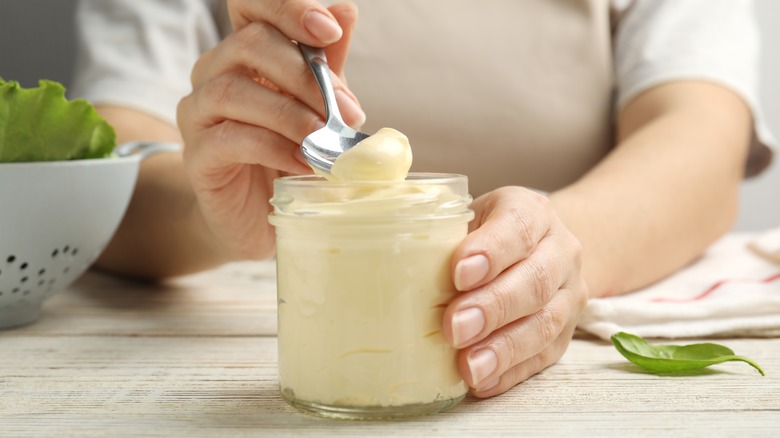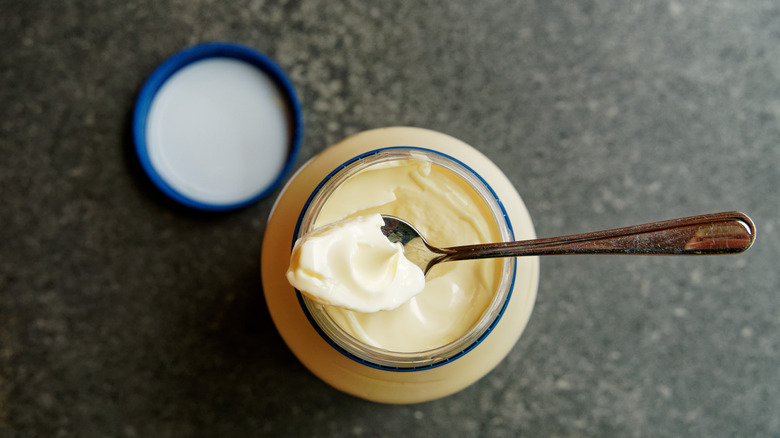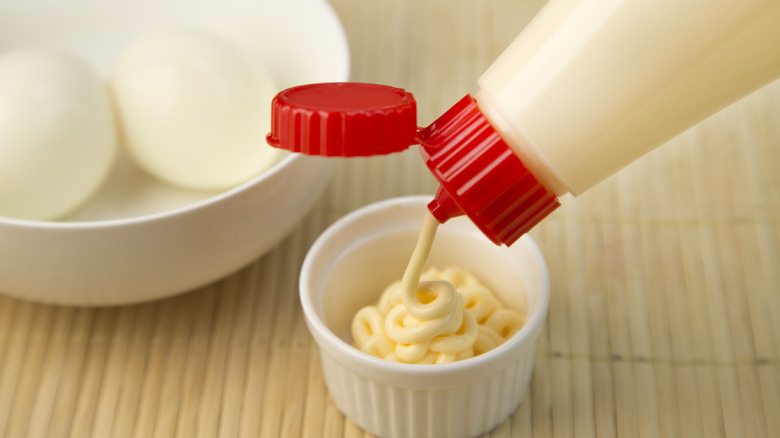How Long Is Mayo Is Good Once It's Open?
Love it or hate it, mayo has staying power. From odd, old-timey jello salads to modern creations like fried deviled eggs, this condiment has a way of holding a wide array of dishes together. However, mayo doesn't stay fresh forever. While it's common to see tiny mayo packets strewn about (unrefrigerated) at fast food joints, or jars of unopened mayo lining the condiment aisle at your local grocery store, once mayo gets opened at home, it's usually stored in the fridge. If you haven't stopped until now to wonder how long it lasts once it reaches your condiment shelf, we've got you covered.
Commercially prepared mayonnaise can remain in the pantry for three to six months. Once opened, it is also technically safe to consume when stored at room temperature, but its quality is best preserved when refrigerated. If you put your mayo in the fridge after opening it, it will last for another two months. If you're feeling ambitious enough to make homemade mayonnaise, it's best to polish it off within four days to ensure freshness and safety. To understand why these differences exist (and why some mayo is safe to store at room temperature), let's see what the science says.
The science behind mayo's shelf life
All mayonnaises have a few things in common: they're emulsions (meaning a blend of two ingredients that don't normally mix), they're acidic (which makes them inhospitable to many bacteria), and they contain ingredients like eggs, oil, vinegar, salt, and other seasonings. Where they differ is how they're preserved — or not. Homemade mayo often uses raw eggs, while commercially-produced mayos include pasteurized eggs, eliminating salmonella concerns. Storebought mayo often includes preservatives like potassium sorbate or calcium disodium EDTA, further extending its shelf-life beyond the homemade stuff.
But be warned, the introduction of contaminants, such as through the act of double-dipping, can invite spoilage. This is a reminder of the delicate balance that maintains mayo's freshness, similar to how even acidic, salty pickles can eventually spoil. Common indicators of mayo spoilage include changes in color, the presence of mold, or an off smell or taste. To ensure mayo remains enjoyable, it needs to be stored properly.
How to maximize the shelf life of any mayo
When it comes to storebought mayo, its shelf life ultimately depends on the brand you choose and its ingredients. For example, Kewpie (the beloved Japanese mayo), claims it does not contain preservatives, which means it should be refrigerated after opening. Although all the common brands contain preservatives, like Hellmann's (aka Julia Child's favorite mayo), Miracle Whip, and Duke's, all offer varied guidance on storage and freshness. For instance, Hellmann's emphasizes the safety of its product at any point within its shelf life, whereas Duke's recommends refrigeration after opening and keeping an eye on best-by dates.
Storage methods matter too. Avoid extremely hot or cold temperatures (especially freezing), as this can cause your mayo's otherwise smooth emulsion to split. Once opened, avoid contaminating your jar's contents with dirty utensils (we see you, sandwich crumbs), to avoid introducing bacteria and food for those bacteria to proliferate.
If you opt to make homemade mayo, adding ingredients like vinegar or lemon juice not only enhances flavor but also increases the acidity level, creating an environment less hospitable to bacteria. Understanding the basics of mayo storage, whether it's the meticulously crafted homemade variety or your favorite store-bought brand, ensures your mayo stays appetizing with every spread and dollop — that is, as long as you're not a mayo hater.


